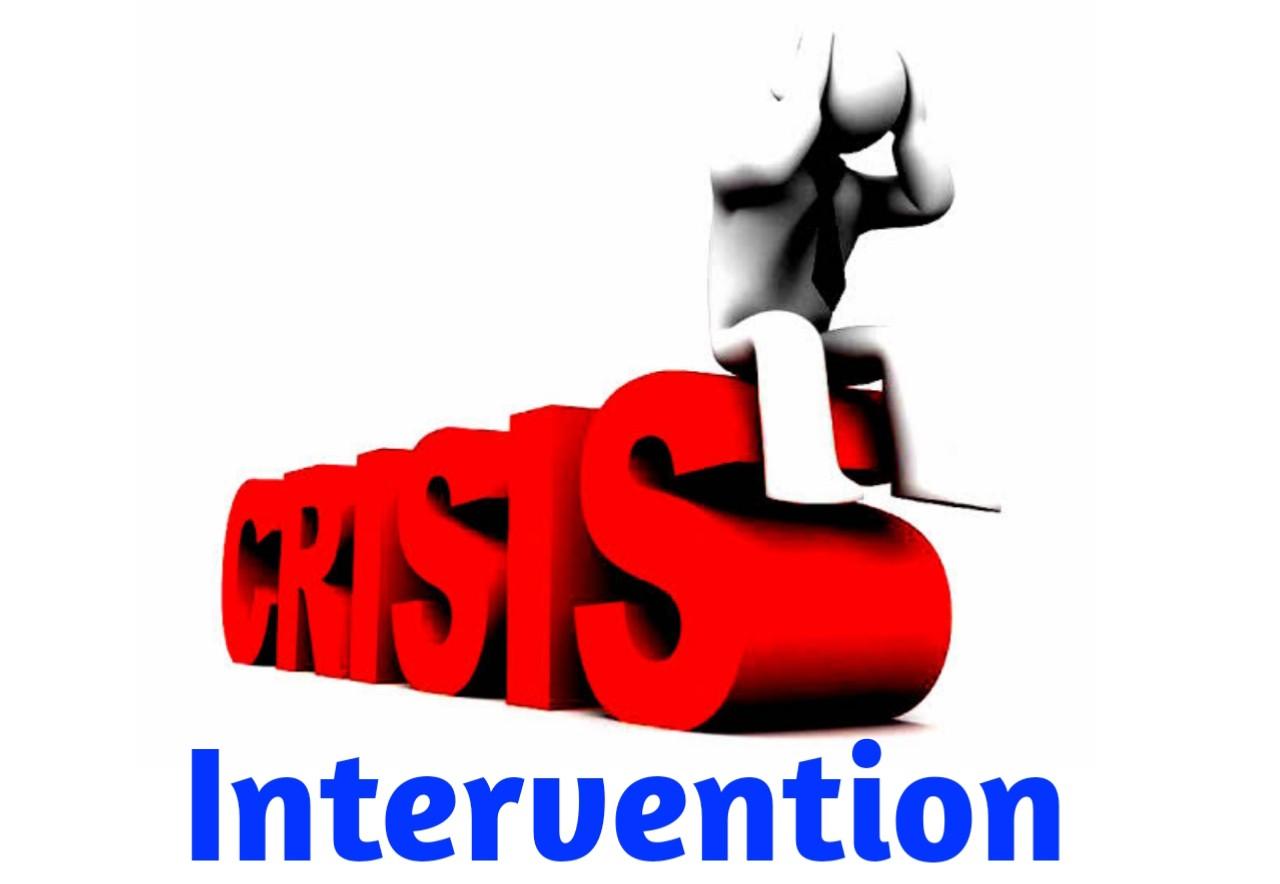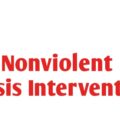What is Crisis Intervention?
Crisis intervention is a time-limited intervention with a specific psychotherapeutic approach to immediately stabilize those in crisis. A crisis can have physical or psychological effects. Usually significant and more widespread, the latter lacks the former’s obvious signs, complicating diagnosis. Three factors define crisis: negative events, feelings of hopelessness, and unpredictable events.
People who experience a crisis perceive it as a negative event that generates physical emotion, pain, or both. They also feel helpless, powerless, trapped, and a loss of control over their lives. Crisis events tend to occur suddenly and without warning, leaving little time to respond and resulting in trauma.
What are the types of crises?
Crises are usually categorized as being either situational or maturational.
Situational crises: involve an unexpected event that is usually beyond the individual’s control. Examples of situational crises include natural disasters, loss of a job, assault, and the sudden death of a loved one.
Maturational crises: occur when a person is unable to cope with the natural process of development. Maturational crises usually occur at times of transition, such as when the first child is born, when a child reaches adolescence, and when the head-of-the household retires.
What are the stages of Crises?
A crisis situation involves a sequence of events that leads individuals from “equilibrium to disequilibrium and back again” (Golan, 1978). This sequence generally involves five components:
- The Hazardous Event: The hazardous event is a stressful circumstance that disrupts an individual’s equilibrium and initiates a series of actions and reactions. The hazardous event may be anticipated (e.g., divorce, retirement) or unanticipated (e.g., the sudden loss of a family member).
- The Vulnerable State: An individual’s reaction to the hazardous event is ordinarily linked to his/her subjective interpretation of the event. Most commonly, a hazardous event is perceived either as a threat, a loss, or a challenge. The vulnerable state is characterized by an increase in tension which the individual attempts to alleviate by using one or more of his/her usual coping strategies. If these strategies are unsuccessful, the individual’s tension continues to increase and, as a result, he/she eventually becomes unable to function effectively.
- The Precipitating Factor: The precipitating factor is the event that converts a vulnerable state into a crisis state. In some situations, the hazardous event and precipitating factor are identical; in other situations, the precipitating factor follows the hazardous event (i.e., the precipitating factor acts as the “last straw”). The precipitating factor may produce a variety of responses including, for example, a suicide attempt or, more constructively, a desire to seek help.
- Active Crisis State: The active crisis state is characterized by disequilibrium and normally involves the following: physical and psychological agitation (e.g., disturbed appetite and/or sleep, impaired concentration and problem-solving ability, anxiety, or depression), preoccupation with the events that led to the crisis, and, finally, a gradual return to a state of equilibrium. The individual ordinarily recognizes during the active crisis stage that his/her usual coping mechanisms are inadequate and, thus, is usually highly motivated to seek and accept outside help.
- Reintegration: Successful reintegration (restoration of equilibrium) is dependent on a number of factors including the individual’s ability to objectively evaluate the crisis situation and to develop and utilize effective coping strategies.
Crisis Intervention Goals
Crisis Intervention Goals The precise goals of a crisis intervention depend, of course, on the specific nature of the crisis.
However, crisis-oriented treatments do share a number of common goals. For example, the general goals of crisis intervention are:
- Relieving the client’s symptoms;
- Restoring the client to his/her previous level of functioning;
- Identifying the factors that led to the crisis state;
- Identifying and applying remedial measures;
- Helping the client connect current stresses with past life experiences; and
- Helping the client develop adaptive coping strategies that can be used in the current situation as well as in any future situation.
Many consider the last two goals “optional” (i.e., feasible only in certain situations), while most agree that the first four are the minimal goals for all types of crisis intervention.
Principles of Crisis Intervention
According to Puryear, crisis intervention is based on the following eight principles:
Immediate Intervention: People are unable to endure crises for long periods of time; thus, crisis interventions must be immediate. If the therapist cannot see a client requesting help immediately, the client should be referred to someone who can. It is when clients request help and are at the peak of their crisis that they are most amenable to treatment; i.e., when they are least defensive and most introspective.
Action: The therapist actively participates in and directs those activities that help the client resolve the crisis.
Limited Goals: While long-term forms of therapy may address a number of goals, crisis intervention focuses on goals that are clearly related to the crisis situation.
Hope and Expectations: Because people in crisis usually feel hopeless, a primary task for the therapist is to instill the expectation that the crisis will be resolved.
Support: Lack of support is ordinarily an important contributing factor to the development of a crisis; thus, provision of support is a crucial factor in crisis intervention.
Focused problem-solving: Crisis interventions are problem oriented; i.e., their emphasis is on resolution of the problem(s) underlying the crisis.
Self-Image: The client experiencing a crisis typically sees him/herself as inadequate. Therefore, the therapist must assume an approach that both protects and raises the client’s self-esteem.
Self-Reliance: From the onset of the crisis intervention, the therapist must maintain a balance between providing support and fostering the client’s self-reliance and independence.
Stages of Crisis Intervention
A number of crisis intervention models have been developed. The model proposed by Golan (1978) involves three stages:
ASSESSMENT (Session 1) The assessment stage of crisis intervention entails:
- Identifying the precipitating factor (“what happened?”);
- Determining the client’s subjective reactions to the precipitating factor (“how did you respond?”);
- Defining the context of the crisis situation including the hazardous event (“can you remember what started this?”);
- Assessing the client’s present state (“what is happening now?”); and
- Precisely defining, in conjunction with the client, the current problem (“we agree that the most important problem is your anxiety about getting along without your husband”).
Note that, depending on the nature of the crisis, assessment of the client may or may not include obtaining a recent medical and psychiatric history, assessing the client’s current mental status, determining if drugs or alcohol are involved, and/or assessing the client’s potential for suicide. At the end of the assessment stage, the therapist and client reach an explicit agreement regarding the goals of the intervention.
IMPLEMENTATION (Sessions 1-4)
The implementation phase involves obtaining relevant background information (e.g., information on the client’s pre-crisis functioning, previously used coping strategies, the client’s strengths and weaknesses, and available resources and support systems), setting immediate goals, and identifying tasks that allow the client to achieve those goals.
TERMINATION (Sessions 5-6)
During the termination phase, the client and therapist review the client’s progress in terms of the goals of the intervention, arrive at a decision to terminate, and discuss the client’s plans for the future. Samuel Dixon (1987) presents a somewhat different model for crisis intervention. Although different than Golan’s, you will notice that both models integrate elements of the overall principles of crisis intervention discussed earlier in this section. Dixon lists nine, more specific steps for helping people in crisis.
The first six steps generally occur during the first session with a client. As necessary, steps 7 and 8 may take up to five weeks.
Establish a positive relationship early in the relationship: The therapist should appear to the client as a “helpful person”; i.e., the therapist should communicate acceptance, be supportive and show respect for the client and an eagerness to help. Essential in this step is a consideration of the client’s feelings with regard to seeking help (e.g., is he or she reluctant, embarrassed, etc.), his or her feelings of helplessness and the degree of the client’s debilitation.
Elicit and encourage expression of painful feelings and emotions: Clients in crisis should be given the opportunity to ventilate painful feelings and emotions before discussing the specific events surrounding the crisis. If the client is visibly distraught, the therapist should encourage such expression before attempting to discuss the reasons for the crisis. In other situations, the client may seem immediately prepared to discuss the crisis event itself and feelings will surface later.
Discuss the precipitating event: Next, the therapist can move on to an exploration of the event that precipitated the crisis. Various aspects of the event should be explored, including when it occurred, the circumstances surrounding it, how the client has tried to resolve the crisis, how the client has coped thus far and what finally made the client seek help. Also helpful is the gathering of information about the client’s history and current life circumstances.
Assess and evaluate: At this point, the therapist uses the information gathered in the earlier steps to assess the cause of the client’s crisis, the degree of debilitation and potential for recovery. Note that the gathering of information necessary for an assessment and evaluation should begin as soon as the therapist and client meet each other. This assessment, along with the following step, forms the basis for treatment planning and implementation.
Formulate a dynamic explanation: This step forms the basis for the client’s cognitive restoration; i.e., it is the basis of client insight and understanding of the crisis itself and his or her reaction to it. Such understanding is essential for change to occur. The dynamic explanation assesses why the client reacted to the crisis as he or she did (as opposed to what he or she has responded to). In this step, the therapist evaluates both the internal (psychic) and external (social) factors that precipitated the crisis and that prevented the client from resolving it without assistance. An assessment of these factors allows the therapist to plan an appropriate intervention.
Restore cognitive functioning: This step is both empathic and intellectual. It permits the client to move beyond the avoidance and defensiveness that characterize the peak of a crisis situation. By providing an explanation for the crisis and an interpretation of the client’s response to it, the therapist helps the client regain both emotional and cognitive control.
Plan and implement treatment: Once the therapist has provided the client with some understanding of the causes and reasons for the crisis condition, specific interventions can be recommended. These can include referrals, environmental modification and/or additional crisis therapy. The therapist should discuss these treatment goals with the client.
Terminate: Termination is indicated when the client has returned to the pre-crisis level of functioning. In addition to resolving the crisis itself, crisis therapy should have helped the client develop overall coping skills that can be applied to later events.
Follow-up: This step is optional. At the end of the last session, the therapist may let the client know that he or she will contact the client sometime in the future to see how he or she is doing. Some therapists believe this fosters dependency; however, clients generally appreciate this show of interest and such follow-up allows the therapist to evaluate therapy outcome.
Crisis Intervention Techniques
The therapist’s selection of specific intervention techniques is based on the nature of the crisis, the therapist’s theoretical orientation and professional background, and the client’s resources. Commonly-used techniques include affective interventions (e.g., helping the client express feelings generated by the crisis), cognitive interventions (e.g., helping the client eliminate negative beliefs that contributed to the crisis), behavioral tasks (e.g., requiring the client to spend more time with other people), and environmental manipulation (e.g., referring the client to an agency that can help alleviate financial problems). According to Hollis, crisis intervention techniques may be classified in terms of four types:
SUSTAINMENT: Sustainment techniques are used primarily during the initial stages of crisis intervention; the goals of sustainment are to lower the individual’s anxiety, guilt, and tension and to provide emotional support. Examples include catharsis, reassurance, encouragement, and sympathetic listening.
DIRECT INFLUENCE: Advising a particular course of action and mobilizing appropriate support systems are examples of direct influence. Direct influence often involves contact with other agencies (e.g., police, courts, social service agencies).
PERSON-SITUATION REFLECTION: Reflection techniques are used to help the client understand and resolve specific aspects of the crisis situation; i.e., the informational aspects (does the client see the situation clearly and objectively?), the client’s part in the crisis situation (is the client aware of the relevance of his/her emotional reactions to the precipitating factor?), and the client’s interaction with the situation (is the client able to use alternative coping strategies?).
DYNAMIC AND DEVELOPMENTAL UNDERSTANDING: Once the client’s intellectual and emotional capabilities permit, it is usually beneficial to explore more deeply the client’s role in the crisis situation (e.g., the defense mechanisms, resistances, and communication patterns that contributed to the crisis). SEE Nonviolent Crisis Intervention





